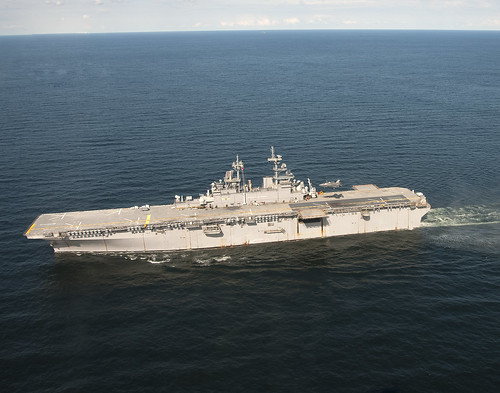China has been in the news a lot lately. The presumptive next president, Xi Jinping, disappeared for a bit last month. The country was kept in the dark about the Communist Party meeting in which the country's leadership will be swapped out, then told it would be delayed until November. The economy continues to sputter.
But the most important news of all--if you get your news from Chinese media--is a fancy new aircraft carrier that was officially "launched" last week. Here's the thing, though. It's not fancy. It's not new. It's not armed. And there is no one trained to use it.
You would never know this from all the attention it is getting, though.
The aircraft carrier was originally launched by the Soviet Navy in 1988. But of course the Soviet Union was in its last days at that point, and the ship--eventually christened the Varyag--was never fully outfitted for combat. By the mid-90s, it had been stripped of pretty much any useful machinery, including engines. And in 1998, China bought it.
That's the provenance of the Chinese carrier, now called the Liaoning. Now let's talk about its capabilities.
As designed, it was essentially a complement to a larger fleet, not the centerpiece of a battle group. Its lack of catapults limited the types of planes it could use; essentially, it could provide combat patrols over the fleet and conduct limited anti-ship or interdiction missions with its two dozen or so aircraft. In short, its purpose is not to project massive offensive firepower, but to provide cover for missile cruisers. (Indeed, another type of Soviet carrier tried to combine both roles.)
Ski jump: great for catching righteous air, but not for launching righteously large aircraft.
This is a sharp contrast to U.S. carrier design. America basically fields two types: supercarriers and amphibious assault craft.
Supercarriers--typified at the moment by the Nimitz class--are meant to project power. They are the focal point of a carrier strike group, which involves other surface ships and submarines, and are what battleships were 75 years ago: the big guns. They carry nearly 100 aircraft, including strike fighters, airborne warning and control planes, electronic warfare, helicopters, and so on. Because it is catapult-equipped, it can also launch heavier air-refueling tankers--and that means the carrier's fighters can theoretically strike targets or patrol airspace over a thousand miles.
Amphibious assault craft are the province of the U.S. Marines and can be equipped in a variety of ways. Overall, though, the Wasp class carries a mix of several dozen fixed-wing aircraft and helicopters, plus a bunch of Marines and a complement of amphibous-landing craft: either LCAC hovercraft or other vehicles.
They also are used to test-fly awesome-looking next-generation fighters.
The Liaoning is nearly the length of a Nimitz-class ship--just a few hundred feet shorter at the waterline. It's a bit heavier than the Wasp class, weighing in at about 50,000 tons compared with 41,000. (Nimitz-class ships typically displace more than 100,000 tons.)
But the important point here is that it is a military match for neither. The nuclear-fueled Nimitz can travel indefinitely, limited only by food supplies. The Wasp has a range of more than 9,000 nautical miles. The Laioning has a range of only 3,800 nautical miles.
Worse, it can't land troops like the Wasp, nor can it control as much airspace as a Nimitz. Designed to protect other ships, the Laioning would essentially have to devote its entire air wing to protecting itself, leaving it with no offensive firepower to spare. In short, it can't project power or even provide a punch beyond what a group of missile cruisers would give on their own. It is a target.
Unfortunately for the Liaoning, that's not even the end of the story.
This is China's first aircraft carrier. That means that the military must now train several thousand seamen to operate the thing--no small feat considering the number of moving parts in modern carrier operations. With such a tiny margin for error and lots of munitions and jet fuel around, mistakes have major consequences. And actually landing on a carrier? That's one of the most difficult feats in aviation. Chinese pilots must be trained to fly carrier-capable aircraft. That aircraft will be the J-15, a copy of the Su-33. And the thing about the J-15 is that it doesn't exist yet.
To sum up, China now has a 25-year-old carrier that can't go very far and has no airplanes or trained pilots to fly them.
In the PLAN's defense, you have to start somewhere. The Liaoning is, at its heart, a proof-of-concept system. Crews will train there, the J-15 will eventually be test-flown there and a decade or so down the line, the navy will have the capability to run a combat-capable carrier. Is the Liaoning that carrier? Not a chance.
So why all the fanfare about this thing? It's simple. If China can get the world to worry about its aircraft carrier, bigger threats--like economic slowdowns and messy power transfers--will disappear in its wake. And that's more dangerous than the Liaoning will ever be.




2 comments:
Nicely done.
Nicely done.
Post a Comment